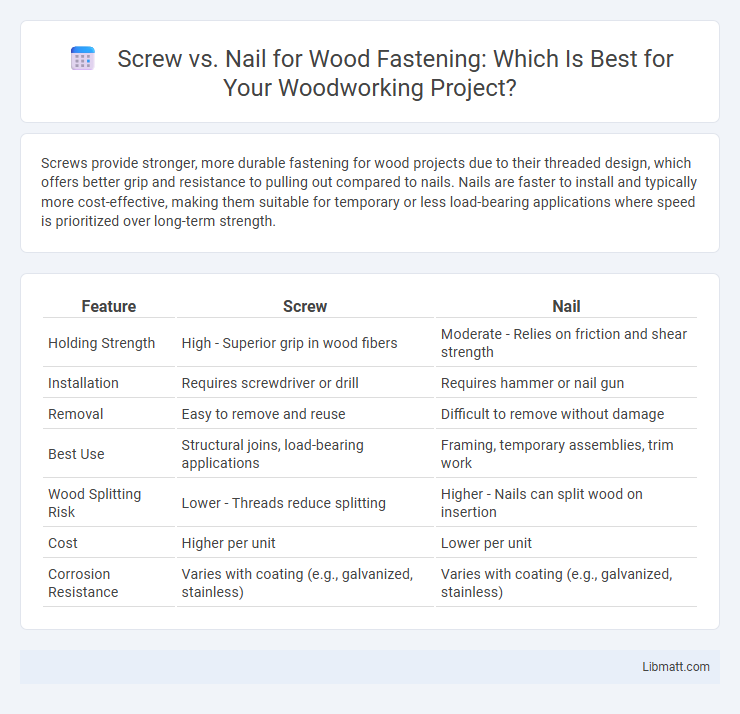Screws provide stronger, more durable fastening for wood projects due to their threaded design, which offers better grip and resistance to pulling out compared to nails. Nails are faster to install and typically more cost-effective, making them suitable for temporary or less load-bearing applications where speed is prioritized over long-term strength.
Table of Comparison
| Feature | Screw | Nail |
|---|---|---|
| Holding Strength | High - Superior grip in wood fibers | Moderate - Relies on friction and shear strength |
| Installation | Requires screwdriver or drill | Requires hammer or nail gun |
| Removal | Easy to remove and reuse | Difficult to remove without damage |
| Best Use | Structural joins, load-bearing applications | Framing, temporary assemblies, trim work |
| Wood Splitting Risk | Lower - Threads reduce splitting | Higher - Nails can split wood on insertion |
| Cost | Higher per unit | Lower per unit |
| Corrosion Resistance | Varies with coating (e.g., galvanized, stainless) | Varies with coating (e.g., galvanized, stainless) |
Introduction: Choosing Between Screws and Nails for Wood Fastening
Screws provide superior holding power and resistance to withdrawal, making them ideal for structural wood fastening and projects requiring strong, long-lasting joints. Nails are preferred for speed and flexibility, offering better shear strength and elasticity in applications like framing or where wood movement occurs. Selecting between screws and nails depends on factors such as load requirements, wood type, and project durability.
Basic Differences: Screws vs Nails
Screws provide superior holding power due to their threaded design, which grips wood fibers more effectively than smooth nails. Nails are faster to install with a hammer or nail gun but offer less resistance to withdrawal and shear forces compared to screws. The choice between screws and nails depends on the specific application, load requirements, and the type of wood being fastened.
Strength and Holding Power Comparison
Screws offer superior strength and holding power compared to nails due to their threaded shafts, which provide greater resistance to pull-out forces in wood fastening applications. The helical design of screws distributes stress more evenly and creates a tighter bond in wood fibers, enhancing durability and structural integrity. Nails, although quicker to install, generally have less withdrawal resistance and are more prone to work loosening under dynamic loads or wood movement.
Speed and Ease of Installation
Nails offer faster installation in wood fastening due to their lightweight design and compatibility with nail guns, allowing rapid driving into materials. Screws provide greater holding strength but require more time for drilling or screwing, often needing pre-drilled pilot holes to avoid wood splitting. For quick and ease-focused projects, nails are preferred, while screws are chosen for durability despite slower installation.
Best Applications for Screws in Wood
Screws are ideal for wood fastening applications that require strong holding power and easy removal, such as cabinetry, furniture assembly, and decking. Their threaded design provides superior grip in hardwood and softwood, making them perfect for structural joints and load-bearing connections. Screws also minimize wood splitting and allow for adjustments during installation, enhancing durability and precision in woodworking projects.
Ideal Uses for Nails in Wood Projects
Nails are ideal for fastening wood in applications requiring quick assembly and flexibility, such as framing, sheathing, and roofing. Their smooth or coated surfaces provide sufficient holding power for structural wooden frameworks while allowing some movement to accommodate wood expansion and contraction. Commonly used nails include common nails for framing and finishing nails for cabinetry and trim work.
Cost Analysis: Screws vs Nails
Screws generally cost more per unit than nails, but their higher holding power can reduce labor time and material waste, potentially offsetting the initial expense in wood fastening projects. Nails are less expensive and suitable for applications requiring speed and shear strength, but they may necessitate additional reinforcement or repairs due to lower withdrawal resistance. Evaluating cost-effectiveness depends on the specific wood fastening application, project scale, and long-term durability requirements.
Durability and Longevity Factors
Screws offer superior durability and longevity for wood fastening due to their threaded design, which provides stronger holding power and resists pull-out more effectively than nails. Nails may loosen over time due to wood expansion and contraction, whereas screws maintain a secure grip, reducing the risk of joint failure. Choosing screws enhances the structural integrity of your wood projects, ensuring lasting performance and reliability.
Impact on Wood: Splitting, Cracking, and Withdrawal
Screws generally cause less splitting and cracking in wood compared to nails due to their threaded design, which distributes pressure more evenly during insertion. Nails, especially when driven without pilot holes, increase the risk of wood splitting and are more prone to withdrawal under stress or aging. The holding power of screws significantly reduces withdrawal, making them more reliable for long-term wood fastening applications.
Conclusion: Making the Right Fastener Choice
Screws provide superior holding power and resistance to pull-out, making them ideal for structural and load-bearing wood fastening. Nails offer quicker installation and better shear strength, suitable for framing and temporary applications where speed and flexibility matter. Choosing the right fastener depends on project requirements like strength, longevity, and ease of removal, ensuring optimal wood connection performance.
Screw vs nail for wood fastening Infographic

 libmatt.com
libmatt.com